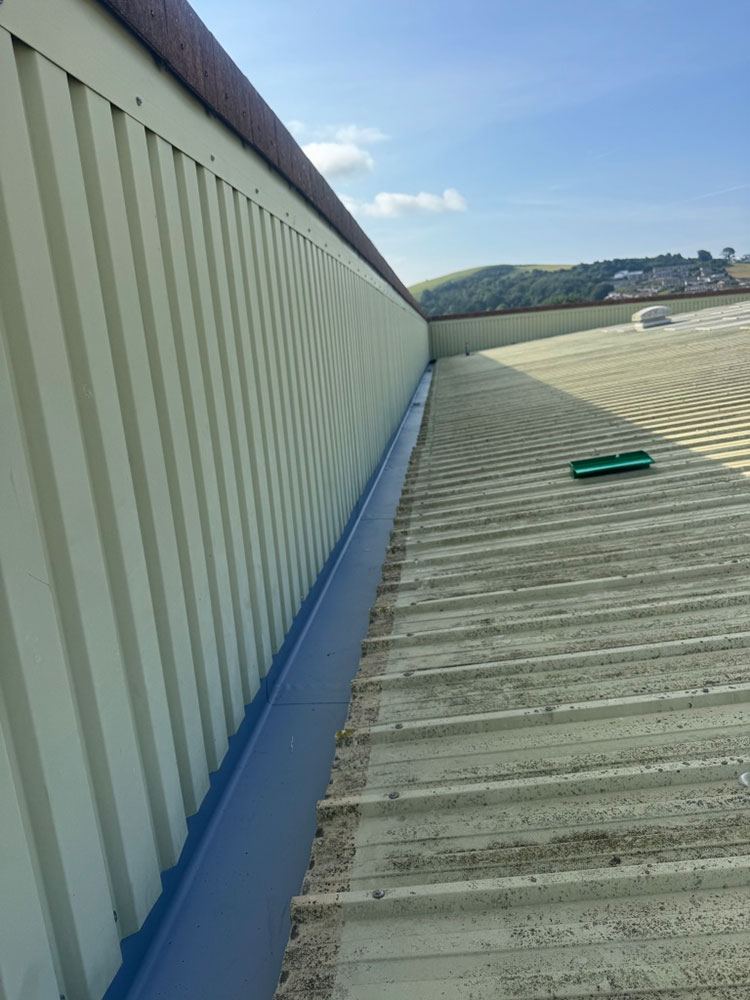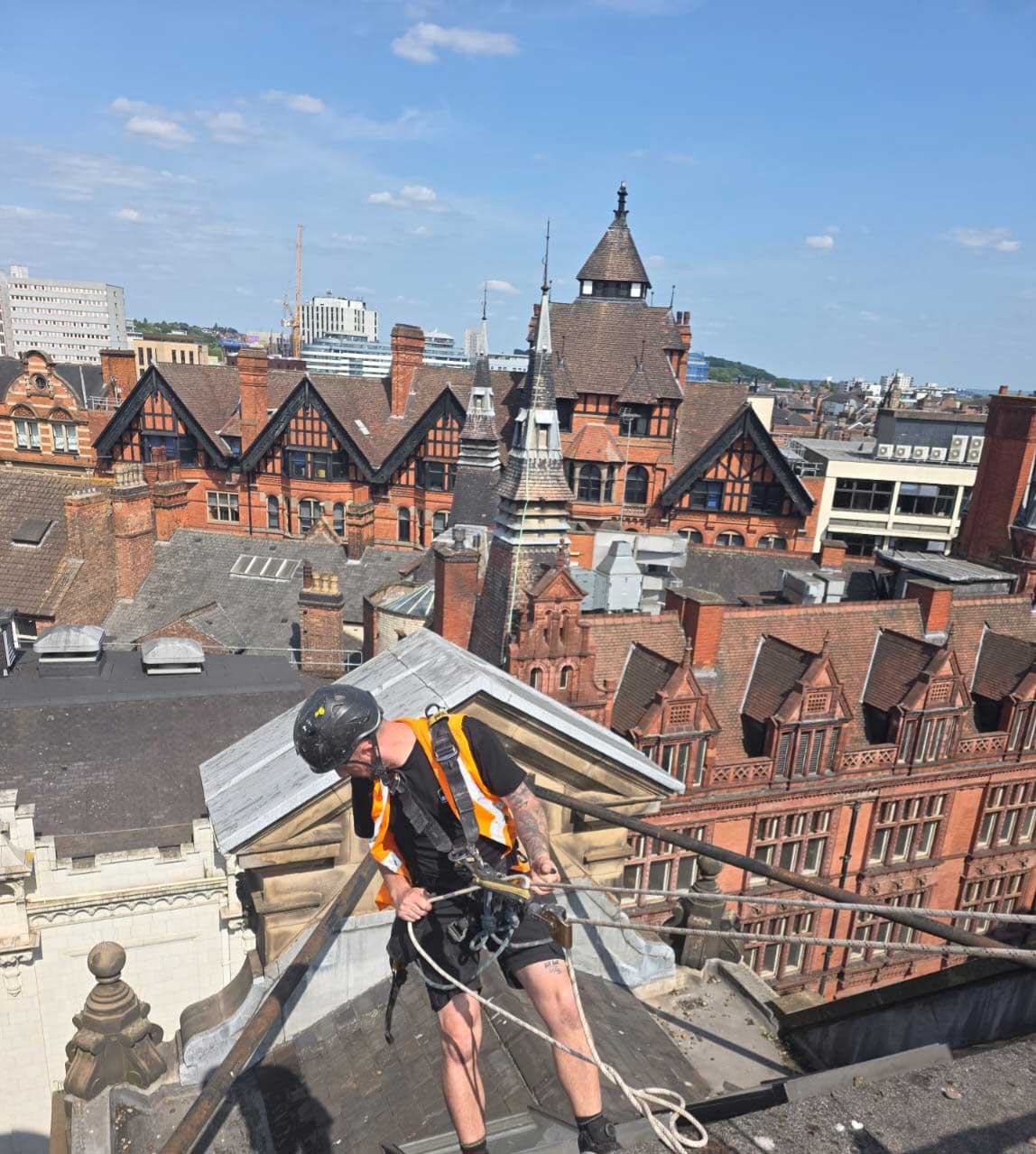
When severe weather strikes your area, your commercial building’s first line of defense—the roof—takes the brunt of nature’s fury. High winds, hail, heavy rain, and flying debris can all inflict significant damage that, if left unaddressed, may compromise the structural integrity of your entire facility and lead to costly interior damage. Identifying and addressing storm damage promptly can mean the difference between a minor repair and a major capital expense.
This guide outlines the critical indicators of storm damage that commercial property owners, facility managers, and maintenance personnel should look for after severe weather events.
Exterior Warning Signs Visible from Ground Level
Before accessing the roof itself, several indicators can be observed safely from the ground.
Displaced or Missing Roofing Materials
Even from ground level, certain material displacements are readily visible:
- Membrane Systems:
- Sections of membrane pulled away from perimeter edges
- Visible billowing or tenting of large membrane sections
- Exposed substrate or insulation where membrane has detached
- Flapping or loose material during even light winds after the storm
- Metal Roofing:
- Missing or lifted panels creating visible gaps
- Panels that appear crooked or misaligned
- Metal trim pieces hanging or detached from edges
- Noticeable color differences where protective coatings have been scoured away
- Built-Up or Modified Bitumen:
- Bare spots where gravel or granule surfacing has been blown away
- Material accumulation in corners or against parapet walls
- Displaced membrane pieces at roof perimeter
Visible Changes to Rooftop Equipment
Roof-mounted equipment can reveal damage clues:
- HVAC Units:
- Air conditioning units visibly shifted from their original position
- Missing covers, panels, or housing components
- Condenser fins bent or damaged
- Units leaning at unnatural angles
- Exhaust Systems:
- Exhaust fans or ventilators that appear crooked
- Missing rain caps or vent covers
- Hood vents twisted or partially detached
- Satellite or Communication Equipment:
- Dishes or antennas pointing in different directions than pre-storm
- Support structures bent or leaning
- Disconnected cables or wiring
Perimeter Evidence
The roof’s edge often shows the first signs of wind damage:
- Metal Edging and Coping:
- Gaps between sections that weren’t present before
- Pieces hanging down or completely detached
- Visible warping or bending
- Metal flashings pulled away from walls
- Drainage Components:
- Downspouts detached or hanging loosely
- Gutters sagging or separated from fascia
- Visible debris clogging scuppers or drains
- Water cascading over edges rather than through drainage systems
Signs Requiring Rooftop Inspection
IMPORTANT SAFETY NOTE: Roof inspections following storms should only be conducted by qualified personnel using proper safety equipment and following OSHA guidelines. Never access a roof if structural damage is suspected.
Membrane System Damage Indicators
Different commercial roofing systems display distinctive damage patterns:
Single-Ply Membrane Damage (TPO, EPDM, PVC)
- Punctures and Tears:
- Clean penetration holes from sharp debris impact
- Linear tears typically running parallel to roof edges
- Abrasions where membrane thickness is visibly reduced
- Star-pattern splits from impact points
- Adhesion Failures:
- Sections of membrane separated from substrate
- Visible bubbles or blisters indicating partial detachment
- Failed seams where membrane sheets join
- Pulled fasteners creating “tenting” between attachment points
- Wind Scouring:
- Erosion of surface coating revealing reinforcement scrim
- Pattern of abrasion in prevailing wind direction
- Exposure of bottom membrane layer in coated products
Modified Bitumen and Built-Up Roof (BUR) Damage
- Surface Material Loss:
- Bare spots where protective granules or gravel have blown away
- Exposed base sheets or membrane plies
- Accumulation of surfacing material in corners or drains
- “Alligatoring” (severe cracking pattern) accelerated by storm impact
- Blister and Ridging Formation:
- Raised areas filled with air or moisture
- Linear ridges typically following insulation board joints
- Soft spots indicating moisture infiltration beneath surface
- Ruptured blisters exposing underlying layers
- Flashing Damage:
- Base flashing pulled away from vertical surfaces
- Counter flashing detached or bent
- Visible gaps at termination bars or reglets
- Mastics or sealants cracked or displaced
Metal Roofing System Damage
- Panel Damage:
- Dents, punctures, or deformation from hail or debris
- Oil-canning (waviness) in previously flat panels
- Scratches or scours through protective finishes
- Bent or crimped standing seams
- Fastener Issues:
- Backed-out screws or missing fasteners
- “Elongated” fastener holes indicating movement
- Broken seam clips or clamps
- Visible rust streams originating from fastener points
- Seam Failures:
- Separated panel connections
- Damaged seam covers or closures
- Crimping or distortion at overlapping edges
- Water staining along seam lines
Structural Component Concerns
Storm damage may affect the structural elements of the roofing system:
Insulation and Substrate Issues
- Moisture Infiltration Evidence:
- Soft spots when walking on roof (indicating wet insulation)
- Compressed or sunken areas between structural supports
- Visible water staining on underside of deck (from interior)
- Warped or deteriorated cover boards
- Mechanical Attachment Failures:
- Popped or backed-out fasteners
- Plates or fastener heads visible through membrane surface
- Linear patterns of membrane stress along fastener rows
- Insulation boards shifted from original position
Structural Deformation
- Deck Support Problems:
- Visible sagging between structural members
- Unusual bounce or sponginess when walking on roof
- New or expanded gaps between roof deck and walls
- Daylight visible through deck from interior
- Perimeter Structure Issues:
- Parapet walls leaning or newly cracked
- Expansion joint covers displaced or damaged
- Misalignment of previously straight roof edges
- Gap formation between different building sections
Impact-Specific Damage
Different storm types create characteristic damage patterns:
Hail Damage Indicators
- Impact Evidence:
- Circular depression patterns on membrane or metal surfaces
- Fractured or crushed rigid materials (skylights, fiberglass panels)
- Granule loss in concentrated circles on modified bitumen
- Splatter patterns where soft hailstones broke apart
- Size Assessment:
- Small hail (under 1″): Light surface marking without membrane penetration
- Medium hail (1-2″): Significant indentations, possible membrane stress
- Large hail (over 2″): Punctures through membrane, severe substrate compression
Wind Damage Progression Patterns
Wind damage follows predictable progression, starting at:
- Stage 1 – Edge Lifting:
- Perimeter flashings and edge details show separation
- Corner areas display the most severe effects
- Membrane edges curl upward
- Stage 2 – Fastener Stress:
- Mechanical attachments show pulling or backing out
- Membranes stretch or elongate around fastening points
- Adhesive bond failures at perimeter transitions
- Stage 3 – Field Failure:
- Large sections of membrane detachment
- “Peeling” effect working inward from edges
- Complete sections missing or displaced
Water Intrusion Evidence
Perhaps the most critical indicator of storm damage is the presence of water entry points:
Active Leakage Signs
- Physical Entry Points:
- Visible tears, gaps, or separated flashings
- Punctures through membrane and substrate
- Failed or separated seams
- Damaged or displaced termination details
- Flow Patterns:
- Silt or debris trails showing water movement paths
- Discoloration streaks on vertical surfaces
- Ponding in areas that previously drained properly
- New water accumulation patterns after rainfall
Interior Indicators
Interior evidence often provides confirmation of roof damage:
- Ceiling Discoloration:
- New water stains on ceiling tiles or drywall
- Pattern of staining that follows roof features above
- Progressive expansion of wet areas after subsequent rainfall
- Yellow/brown discoloration indicating dissolved roofing materials
- Structural Evidence:
- Moisture meters showing elevated readings in structural components
- Dripping from previously dry areas during or after rain
- Water accumulation in light fixtures or HVAC diffusers
- Unexplained humidity increases in previously dry areas
Critical Next Steps After Identifying Damage
Once potential damage is identified, prompt action is essential to mitigate further damage and position your claim appropriately.
Documentation Protocols
Thorough documentation strengthens both insurance claims and warranty coverage:
- Photographic Evidence:
- Close-up images of specific damage points
- Wide-angle context shots showing damage extent
- Comparison photos with pre-storm images if available
- Time/date stamped images clearly tied to the storm event
- Measurement and Mapping:
- Measured dimensions of damaged areas
- Roof plan with damage locations clearly marked
- Quantification of affected materials
- Documentation of progression if multiple inspections occur
- Narrative Description:
- Detailed written account of findings
- Correlation between damage and specific storm characteristics
- Chronology of observations and actions taken
- Statements from witnesses or building occupants reporting issues
Emergency Temporary Protection
Before permanent repairs, temporary measures may be necessary:
- Water Intrusion Control:
- Appropriate temporary coverings (tarps, temporary membranes)
- Creation of temporary drainage paths
- Strategic placement of interior water collection systems
- Application of emergency sealants at critical entry points
- Debris Management:
- Removal of loose material that could cause additional damage
- Securing of partially attached components
- Clearing of drainage paths to prevent ponding
- Removal of sharp objects that could puncture temporary coverings
Professional Assessment Requirements
Beyond initial observations, comprehensive professional evaluation ensures proper response:
- Roofing Specialist Inspection:
- Certified commercial roof inspector assessment
- Thermal scanning to identify hidden moisture infiltration
- Core sampling where subsurface damage is suspected
- Test cuts to verify condition of underlying components
- Structural Engineering Review:
- When significant structural involvement is suspected
- When multiple roof sections show misalignment
- If interior structural elements show deformation
- When building movement is evident
- Insurance Coordination:
- Prompt notification to carrier within policy timeframes
- Adherence to claim documentation requirements
- Cooperation with insurance adjuster investigation
- Obtaining competing repair/replacement estimates
Common Areas of Frequently Missed Storm Damage
Thorough inspection should include often-overlooked areas where damage frequently occurs:
Concealed Components
Some critical damage points remain hidden without special attention:
- Roof System Transitions:
- Changes in elevation between roof sections
- Intersections of different roofing materials
- Areas where newer roofs join older sections
- Interface between horizontal and vertical surfaces
- Mechanical Curbs and Penetrations:
- Flashing around HVAC equipment bases
- Pipe penetrations and conduit entry points
- Support structure attachments
- Expansion joint covers and details
- Drainage System Components:
- Interior drain connections below visible surface
- Scupper linings and through-wall flashings
- Concealed gutter attachments
- Overflow system integrity
Secondary Effects
Storm damage often creates secondary conditions that may not immediately appear problematic:
- Compression and Displacement:
- Shifted insulation boards creating uneven surfaces
- Compressed insulation reducing R-value
- Altered slope affecting drainage patterns
- Displaced protection materials exposing sensitive components
- Material Fatigue:
- Stress points from wind flutter not yet failed
- Micro-cracking in brittle materials
- Loosened but not detached fasteners
- Material stretching reducing future performance
- System Contamination:
- Sediment/debris infiltration in open seams
- Biological matter introduction (seeds, spores)
- Chemical contaminants from airborne sources
- Moisture trapped within system components
Implications for Different Commercial Roof Types
Different roofing systems have unique vulnerability profiles during storms:
Single-Ply Membrane Systems
Wind and impact vulnerabilities vary by attachment method:
- Fully-Adhered Systems:
- Adhesive bond failure from sudden pressure changes
- Corner and perimeter lifting due to negative pressure
- Substrate failure when adhesion remains intact
- Membrane stretching and elongation under stress
- Mechanically-Attached Systems:
- Fastener pullout during wind uplift events
- “Billowing” between fastener rows
- Membrane tearing around fastener plates
- Seam failures from repeated movement
- Ballasted Systems:
- Ballast scour exposing membrane
- Impact damage from displaced ballast materials
- Uneven protection after ballast redistribution
- Wind vortices removing significant ballast sections
Built-Up and Modified Bitumen Systems
Multi-ply systems demonstrate distinctive damage patterns:
- Surface Degradation:
- Loss of protective surfacing exposing membrane
- Accelerated UV degradation after surface loss
- Alligatoring and checking from impact stress
- Blister formation from moisture intrusion
- Attachment Issues:
- Adhesion failure between plies
- Base sheet detachment from substrate
- Cap sheet separation
- Edge metal attachment failures
Metal Panel Systems
Metal roofing damage often affects both functionality and aesthetics:
- Panel Integrity Issues:
- Hail impact deformation
- Wind-driven debris punctures
- Edge crimping from uplift forces
- Protective coating removal leading to corrosion initiation
- Connection Failures:
- Clip disengagement at standing seams
- Fastener backing out or pull-through
- End lap separation
- Trim and flashing attachment failures
Proactive Preparation for Future Events
After addressing immediate storm damage, consider system improvements to reduce future vulnerability:
Enhanced Resistance Measures
When repairing or replacing, consider upgrades:
- Wind Resistance Enhancements:
- Increased perimeter and corner mechanical fastening
- Enhanced edge metal profiles and attachment
- Reinforced membrane specifications in vulnerable areas
- Wind deflectors at critical uplift points
- Impact Resistance Upgrades:
- Higher puncture-resistance membrane specifications
- Protective walkway materials in hail-prone regions
- Rigid protection boards over insulation
- Hail guards for vulnerable equipment
- System Redundancy Improvements:
- Secondary drainage enhancement
- Underlayment upgrades for metal systems
- Additional plies at vulnerable transitions
- Reinforced recovery board installation
Maintenance Program Adjustments
Storm experiences should inform ongoing maintenance:
- Inspection Frequency Recalibration:
- Additional inspections during storm seasons
- Focus on previously damaged areas
- Specific attention to repair integration points
- Regular assessment of vulnerable details
- Preventative Measures:
- Pre-storm preparation protocols
- Loose debris removal program
- Drainage system cleaning schedule adjustment
- Regular adhesion testing at perimeters
Conclusion
Commercial roof storm damage requires prompt, thorough evaluation and response. By understanding the specific signs of damage most relevant to your roofing system, you can prioritize assessment areas, document findings effectively, and implement appropriate repairs before secondary damage occurs. Remember that some storm effects may not be immediately obvious, making professional assessment a critical component of your post-storm response plan.
Regular inspection, proper documentation, and timely intervention after storm events will maximize your roof’s service life, protect the valuable assets beneath it, and ensure business continuity despite challenging weather conditions. When in doubt about potential damage, consulting with a qualified commercial roofing professional provides the most reliable path to system preservation and protection.









